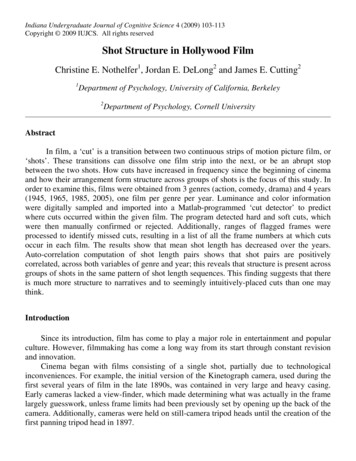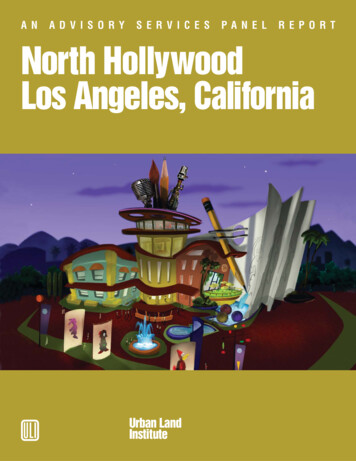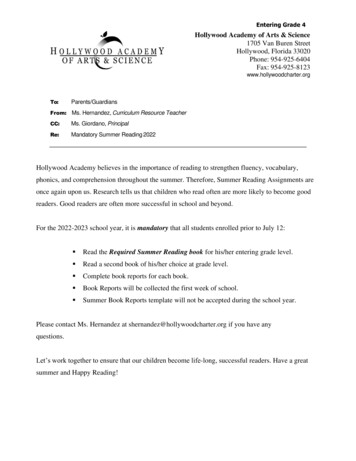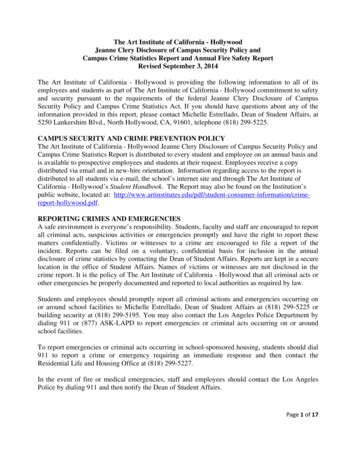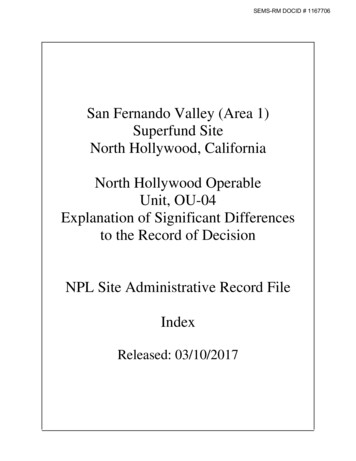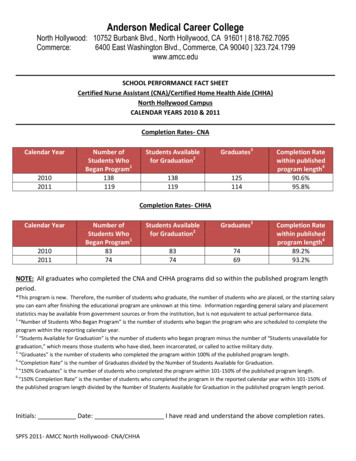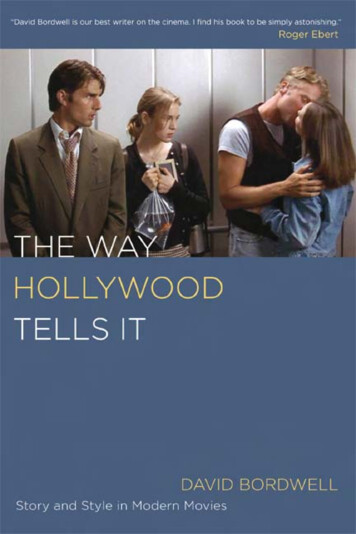
Transcription
The Way Hollywood Tells It
The publisher gratefully acknowledges the generous contributionto this book provided by the Humanities Endowment Fund of theUniversity of California Press Foundation.
The Way Hollywood Tells ItStory and Style in Modern Moviesdavid bordwellUniversity of California Pressberkeleylos angeleslondon
University of California Press, one of the most distinguished universitypresses in the United States, enriches lives around the world byadvancing scholarship in the humanities, social sciences, and naturalsciences. Its activities are supported by the UC Press Foundation andby philanthropic contributions from individuals and institutions. Formore information, visit www.ucpress.edu.University of California PressBerkeley and Los Angeles, CaliforniaUniversity of California Press, Ltd.London, England 2006 by The Regents of the University of CaliforniaA previous version of “A Stylish Style,” entitled “IntensifiedContinuity: Visual Style in Contemporary American Film,”appeared in Film Quarterly 55, no. 3 (2002).Library of Congress Cataloging-in-Publication DataBordwell, David.The way Hollywood tells it : story and style in modern movies /David Bordwell.p.cm.Includes bibliographical references and index.isbn 0-520-23227-5 (cloth : alk. paper)isbn 0-520-24622-5 (pbk. : alk. paper)1. Motion pictures—United States—History. 2. Motion pictureindustry—United States—History. 3. Motion pictures—Aesthetics. I. Title.pn1993.5.u6b656 2006791.430973—dc222005025774Manufactured in the United States of America151014 13 129 8 7 611 10 09 085 4 3 2 10706The paper used in this publication meets the minimum requirementsof ansi/niso z39.48–1992 (r1997) (Permanence of Paper).
For KristinThe road goes ever on.
Contentspart i:AcknowledgmentsixIntroduction: Beyond the Blockbuster1a real story191. Continuing Tradition, by Any Means Necessary272. Pushing the Premises513. Subjective Stories and Network Narratives724. A Certain Amount of Plot:Tentpoles, Locomotives, Blockbusters,Megapictures, and the Action Moviepart ii:a stylish style1041151. Intensified Continuity: Four Dimensions1212. Some Likely Sources1393. Style, Plain and Fancy1584. What’s Missing?180Appendix: A Hollywood Timeline, 1960–2004Bradley Schauer and David Bordwell191Notes243Index273
AcknowledgmentsThe two archival linchpins of my research, the Wisconsin Center for Filmand Theater Research and the Cinémathèque Royale de Belgique, were asusual magnificently cooperative over the ten years during which I gatheredmaterial for this book. So thanks to Maxine Fleckner Ducey of Madison, toGabrielle Claes of Brussels, and to their staffs. I’d also like to thank TedTurner and Warren Lieberfarb, two far-sighted moguls who have increasedour access to the majestic range of American cinema.Many colleagues encouraged this project, written during my last semester before retiring from the Film Studies area of our department. JoeBeres, Ben Brewster, Kelley Conway, Kevin French, Erik Gunneson, Debbie Hanson, Michele Hilmes, Lea Jacobs, the late Nietzchka Keene, VanceKepley, Paddy Rourke, Ben Singer, and Andrew Yonda aided me in manyways. J. J. Murphy, who was writing a book on contemporary American filmat the same time that I was, proved a constant source of hard questions andfruitful suggestions. Tino Balio let me draw on his vast expertise in theAmerican film industry. He further displayed his wisdom by deciding toretire along with me.I’ve also benefited from watching American movies with Noël Carroll.Our long comradeship has been a high point of my life. Paul Arthur, DougGomery, Jason Mittell, and Jeff Smith offered detailed and very useful criticisms of various versions of these essays. Consultant and filmmaker TimOnosko, film editor Danny Goldberg, and screenwriter Larry Gross sharedinformation and ideas. In Los Angeles, Cameron Crowe, Andy Fischer, andSusan Antani kindly helped in several ways. Roger Ebert and Nate Kohnexpanded my access to contemporary work through their annual Overlookedand Forgotten Film Festival. Special thanks go to John Caldwell of UCLA,ix
x/AcknowledgmentsMurray Smith of the University of Canterbury, and to my editor, Mary Francis; their astute criticisms have strengthened the book.The second essay, “A Stylish Style,” is based on an article originally published in Film Quarterly. Thanks to the editor, Ann Martin, and to the University of California Press for permission to reprint.My students have helped too. Jake Black provided expert assistance inpreparing my frame enlargements. Brad Schauer left me shrewd commentson an early draft, while helping me check facts and compile the chronology in the appendix. Jinhee Choi, Ethan de Seife, Jonathan Frome, JaneGreene, Patrick Keating, Michael Newman, and Paul Ramaeker offered several productive leads. For sharing some thoughts on puzzle films, I mustthank Vincent Bohlinger, Jessica Love, Mark Minnett, and especially Barbara Klinger, who kindly gave me access to portions of her book Beyondthe Multiplex: Cinema, New Technologies, and the Home. My last (official )seminar in the Department of Communication Arts at the University ofWisconsin at Madison was just the way you want to go out. My gratitude,then, to Masha Belodubrovskaya, Jen Chung, Eric Crosby, Stew Fyfe, DerekJohnson, Jonathan Lang, Maureen Larkin, Pearl Latteier, Charlie Michael,Jakob Nilssen, Eija Niskannen, Dave Resha, Brad Schauer, Becca Swender,and Tom Yoshikami for responding so vigorously to ideas that I floated inclass, some of which drifted into these pages. Our final session, party andall, remains with me always.The University of Wisconsin at Madison has generously supported myresearch for over three decades, and I thank all those faculty members whosat on committees appraising my work. Mary Anne Fitzpatrick, departmentcolleague and dean, has been of inestimable aid as well. I particularly wantto thank my former dean, Phillip Certain, who has had faith in my projectsand our film program. He too has just retired (must be something in thewater), but he remains a model of the thoughtful, solicitous administrator.Then there’s Kristin Thompson, for thirty years my loving companionat the movies and elsewhere. The book is dedicated to her.
introductionBeyond the Blockbusterq: Do you write with specific actors in mind?a: Always . . . but they’re usually dead.charles shyer(Private Benjamin, Irreconcilable Differences)This book is about the art and craft of Hollywood cinema since 1960. In twoessays I trace some major ways that filmmakers have used moving imagesto tell stories. The narrative techniques I’ll be examining are astonishinglyrobust. They have engaged millions of viewers for over eighty years, andthey have formed a lingua franca for worldwide filmmaking.Naturally, during the years I’m considering, American films have changedenormously. They have become sexier, more profane, and more violent; fartjokes and kung fu are everywhere. The industry has metamorphosed intoa corporate behemoth, while new technologies have transformed production and exhibition. And, to come to my central concern, over the samedecades some novel strategies of plot and style have risen to prominence.Behind these strategies, however, stand principles that are firmly rooted inthe history of studio moviemaking. In the two essays that follow I considerhow artistic change and continuity coexist in modern American film.To track the dynamic of continuity and change since 1960, it’s conventionalto start by looking at the film industry. As usually recounted, the industry’s fortunes over the period display a darkness-to-dawn arc that mightsatisfy a scriptwriter of epic inclinations. We now have several nuanced versions of this story, so I’ll merely point out some major turning points.1 Theappendix provides a year-by-year chronology.Although court decisions of 1948–1949 forced the major companies todivest themselves of their theater chains, during the 1950s Warner Bros.,Disney, Paramount, Columbia, 20th Century Fox, United Artists, MGM, andUniversal controlled distribution, the most lucrative area of the industry.While the studios were producing a few big-budget films themselves, theyalso relied on the “package-unit” system of production.2 In some cases, in1
2/Introductionhouse producers oversaw a unit that turned out a stream of releases. Alternatively, a producer, star, or agent bought a script, assembled a package oftalent, and approached a studio for financing and distribution. At the startof the 1960s, the studios were providing lucrative prime-time television programming, but theatrical moviemaking was not a great business to be in.Attendance was falling sharply. Road show pictures like The Sound of Music (1965), playing a single screen for months on end, were for a while brightspots on the ledger, but the cycle of epic road show productions, already overstretched with the failure of Cleopatra (1963) and Mutiny on the Bounty(1965), crashed at the end of the decade. Soon studios faced huge losses andwere taken over by conglomerates bearing mysterious names like Gulf Western (which bought Paramount in 1966) and Transamerica Corp. (whichbought United Artists the following year). Feature filmmaking continuedto hemorrhage money—by some estimates, as much as half a billion dollars between 1969 and 1972.Yet by 1980 the industry was earning stupendous profits. What changed?For one thing, a tax scheme sponsored by the Nixon administration allowedthe producers to write off hundreds of millions of dollars in past and futureinvestments. The studios also found ways to integrate their business morefirmly with broadcast television, cable, the record industry, and home video.3Just as important, a new generation of filmmakers emerged. Some, modeling their work on the more personal European cinema they admired, produced Americanized art films like Five Easy Pieces (1970) and Mean Streets(1973). The young directors who found the biggest success, however, werewilling to work in established genres for a broad audience. They were responsible for a burst of record-breaking hits: The French Connection (1971),The Godfather (1972), The Exorcist (1973), American Graffiti (1973), Jaws(1975), Saturday Night Fever (1977), Star Wars (1977), and Close Encounters of the Third Kind (1977). There were less innovative top-grossers aswell, such as Fiddler on the Roof (1971) and The Sting (1973). In all, the1970s lifted the ceiling on what a film could earn, and it remains the decadewith the most top-grossers in adjusted dollars. On its U.S. release, Jawsreaped about 260 million—the equivalent of 940 million today. Star Warstook in over 307 million on its initial domestic release (a staggering 990million in 2005 dollars), and after rereleases it became by far the top-earningfilm of the modern era.4No films had ever made so much money so quickly. The studios’ decisionmakers realized that the market for a movie was much bigger than anyonehad suspected, and they settled on a business strategy to exploit the“megapicture,” or blockbuster. This was a must-see movie very different
Introduction/3from the road show attraction. Budgeted at the highest level, launched inthe summer or the Christmas season, playing off a best-selling book or apop-culture fad like disco, advertised endlessly on television, and then opening in hundreds (eventually thousands) of theaters on the same weekend,the blockbuster was calculated to sell tickets fast. By the early 1980s, merchandising was added to the mix, so tie-ins with fast-food chains, automobile companies, and lines of toys and apparel could keep selling the movie.Scripts that lent themselves to mass marketing had a better chance of beingacquired, and screenwriters were encouraged to incorporate special effects.Unlike studio-era productions, the megapicture could lead a robust afterlifeon a soundtrack album, on cable channels, and on videocassette. By themid-1980s, once overseas income and ancillaries were reckoned in, few filmslost money.The new release system demanded an upgrade in exhibition as well. Inthe 1970s those downtown theaters or road show houses that weren’t demolished had been chopped up into lopsided, sticky-floored auditoriums. Butthe blockbuster showed to best advantage in venues with comfortable seating, a big screen, and surround-sound systems, so in the 1980s exhibitorsbegan building well-appointed multiplex theaters. The multiplex providedeconomies of scale (fewer projectionists and concession workers per screen),and it proved ideal for megapictures, which opened on several screens eachweekend.5The blockbuster reshaped the industry, but very few projects were conceived on that scale. In any given year, the major companies and independent distributors released between two and five hundred films. Most weregenre pictures—dramas, comedies, action movies, children’s fare, and othermid-range items. Cable and video had an omnivorous appetite, so independent production flourished, from the down-market Troma and its gross-outhorror, to the high-end Orion, purveyor of Woody Allen dramas. A radically low-budget independent sector created its own hits, like Stranger ThanParadise (1984) and She’s Gotta Have It (1986). The success of this sector innurturing young talent and attracting upscale consumers led studios to buythe libraries of indie companies. The majors also launched specialty divisions, notably Miramax and New Line, which acquired films for niche distribution and could produce their own projects at lesser budget levels.The industry’s success nourished a new kind of acquisition mentality.Now entrepreneurs in other leisure industries saw movies as generating“content” that could be run through publishing, television, theme parks,and other platforms.The Walt Disney company had pioneered this approach,but other firms took it up, starting with Rupert Murdoch’s purchase of 20th
4/IntroductionCentury Fox in 1985. By 2003, with General Electric/NBC’s acquisition ofUniversal Pictures, no major distributor stood outside an entertainmentcombine. Initially, the drive was to maximize synergy. Batman could undergo a hard-edged makeover in his comic book and then become the heroof a new movie, which yielded soundtrack albums, sequels, and an animatedTV series—all because Time Warner owned DC Comics, a movie distribution firm, and a music company. Synergy did not always work so smoothly,but it was clear by the mid-1980s that “intellectual property” was endlesslylucrative, and conglomerates were in the best position to nurture and market it around the world.Consumers responded. Despite home video and other entertainment rivals, attendance at U.S. movie theaters soared to 1.5 billion viewers a year.The overseas market grew too, partly thanks to the multiplex habit. On average, U.S. films drew half their theatrical income from overseas, while worldwide home video surpassed theatrical income. The 1990s saw a boost in income for the industry generally, but the decisive development was the arrivalof the DVD in 1997. Designed to be sold as well as rented, the DVD formatsoon pushed the videocassette into oblivion. In 2004 the major studios’ theatrical releases grossed 9.5 billion worldwide, but DVD sales and rentalyielded over 21 billion.6 Now DVDs were keeping virtually every movie’sbudget afloat.The downside was that digital reproduction made massive piracyeasy. In China bootleg DVDs sold for less than a dollar. The appetite arousedby Hollywood for event pictures, the sense that you’re not in touch with contemporary culture unless you’ve seen this weekend’s hit, came back to hauntthe studios when anyone with high-speed Internet access could downloadmovies that had not yet opened.The next task for the industry would be finding a way to distribute films in digital form—to theaters, to homes via theInternet, and eventually to personal digital devices like cellular phones.A tale of last-minute rescues—the industry saved by the blockbuster, thenby home video and the multiplex, then by DVD—is always captivating, butAmerican cinema is more than a business. Since the late 1910s, Hollywoodcinema has constituted the world’s primary tradition of visual storytelling,and despite the four decades of industrial upheaval just chronicled, this tradition has remained true to its fundamental premises. In an earlier book,The Classical Hollywood Cinema (1985), two colleagues and I sought to analyze the narrative principles governing studio-era filmmaking, from 1917to 1960. We picked the endpoint as a matter of convenience, since we believed that the classical system was still flourishing. This book is an effortto back up that belief.
Introduction/5Since we made our initial foray into this terrain, the boundary lines haveshifted. Some scholars have suggested that however valid our accountmight be for the studio era, dramatic changes have taken place since 1960,and especially since the late 1970s. There is, they claim, a “postclassical”cinema—taken either as U.S. studio filmmaking as a whole or as the dominant trend within it.7 We can trace this line of argument through severalstages, all connected in one way or another to the rise of the blockbuster.Megapictures may have saved the major companies, but they also shrankthe auteur aspirations of the early 1970s. Did Hollywood storytellingchange in response to the blockbuster phenomenon, and if so, in what ways?From American Graffiti (1973) to Jaws (1975) to Star Wars (1977), film historian Thomas Schatz suggests, films became “increasingly plot-driven, increasingly visceral, kinetic, and fast-paced, increasingly reliant on special effects, increasingly ‘fantastic’ (and thus apolitical ), and increasingly targetedat younger audiences.”8 Several commentators suggest that storytelling wasundercut by spectacle. One scholar, denouncing the “violent spectacle” ofthe big-budget movie, speaks of “the collapse of narrative.”9 Others claimthat stylistic unity evaporated. Contemporary Hollywood films, accordingto one writer, “cannot be seen as unified as was possible under the old oligopoly. Stylistic norms have changed, and perhaps no longer exist as a consistent group of norms.”10What made narrative cinema crumble? The causes commonly cited areindustrial. Since the 1970s, companies have split and recombined, the marketplace has splintered into dozens of demographics, and merchandising hasspun off ancillary products. “Equally fragmented, perhaps,” writes Schatz,“are the movies themselves, especially the high-cost, high-tech, high-stakesblockbusters, those multi-purpose entertainment machines that breed music videos and soundtrack albums, TV series and videocassettes, video gamesand theme park rides, novelizations and comic books.”11 Contemporary cinema, claims another historian, directs its energies “more to the pursuit ofsynergy than to that of narrative coherence.”12 An indie producer-writerhas argued that action pictures like Volcano (1997) and Independence Day(1996) don’t need classical narrative construction because their narrativeswill be “fragmented” into CD soundtracks and T-shirt logos. “The supposed‘identity’ of the filmic text comes increasingly under the dissolving pressures of its various revenue streams.”13Comparable arguments have been made about the “high-concept” film,typified by Saturday Night Fever (1976), American Gigolo (1980), and Flashdance (1983). Justin Wyatt has proposed that such films’ musical interludesand stereotyped characters rendered plot and psychology secondary. Stars
6/Introductiondid not so much perform as strike magazine-ad poses, and TV-commercialimagery made style itself a major appeal; this favored the marketing of spinoff fashions, soundtracks, and videos. Wyatt argues that high concept grewout of the blockbuster syndrome and became a central development of postclassical cinema.14Eventually these lines of argument encountered objections. MurraySmith proposed that claims of plot fragmentation and stylistic collapse wereoverstated; even blockbusters showed “careful narrative patterning.”15Smith and Peter Krämer suggested that conceptions of “postclassical” cinema rested on intuitive comparisons rather than on thorough and systematic analyses of films.16 When a scholar examined Raiders of the Lost Ark(1980), he found the film’s plot and narration to be quite strongly unified.17Similarly, Geoff King argued that the spectacle-narrative split was not apteven for the theme-park movie: “The demands of the blockbuster may haveled to an emphasis on certain genres and on more episodic forms of narrative, but this is not the same as narrative being displaced.”18Most comprehensively, Kristin Thompson examined several dozen post1960s films and analyzed ten in detail in her book Storytelling in the NewHollywood (1999). Her studies show that even blockbusters like Jaws andTerminator 2 (1990) display highly coherent storytelling. Other films sheanalyzes, such as Hannah and Her Sisters and Desperately Seeking Susan(both 1985), are more character centered, but these “independent” productions also remain committed to classical premises. Thompson also offeredgeneral arguments against the power of merchandising to shape storytelling.To suggest that a film’s plot “fragments” into a shrapnel burst of tie-ins,she points out, is to indulge in misleading rhetoric. The film itself isn’t fragmented by its publicity: “One model of car can be marketed to college kidsand to young professionals using different ads, but the individual vehiclesdo not cease to run as a result.”19 The fact that a film will be hyped on manyplatforms mandates nothing about its form and style.As for the role of high concept, it now seems clear that the term can meanat least three things. The high-concept movie, it’s usually said, is one thatcan be encapsulated in a single sentence, usually called a logline.20 Nowadaysevery film needs to be summed up in an enticing way on the first page of ascript or during a pitch session. But any film from any period of Hollywoodhistory can be reduced to one intriguing sentence, as TV listings in newspapers show. Although the logline is important as a production practice, byitself it doesn’t seem to distinguish “high-concept” projects from others. Amore specific sense of the term denotes a movie sold on the strength of anunusual plot idea that will work without stars. “High concept is story as star,”
Introduction/7notes one screenplay manual.21 The Exorcist, Jaws, and Star Wars lured inaudiences with bold premises, not stellar casts. Yet stars have embraced highconcept projects, from Tootsie (1982) to What Women Want (2000). A 2002Variety report on recent concept-driven properties suggested that those without stars had trouble getting attention or getting released.22 Wyatt’s mostvivid specimens of high concept illustrate a third sense of the term, one associated with a particular 1980s production cycle. American Gigolo and Flashdance do display bold music and slick visuals, but they were rarities in a fielddominated by films as stylistically unprepossessing as 9 to 5 (1980), Stir Crazy(1980), Any Which Way You Can (1980), Terms of Endearment (1983), andWarGames (1983)—all of which did much better at the box office.23 Wyatt’sresearch skillfully captures a distinct trend in early 1980s cinema, but thefilms’ fashion-layout gloss remains a fairly isolated phenomenon.Given the evidence that even blockbusters can be quite narratively coherentand that the high-concept style covers only a fraction of Hollywood’s output, the postclassical position has become less plausible.24 Today, the argument revolves largely around one aspect of modern movies: their frequentallusions to other movies. Noël Carroll was one of the first scholars to writeabout this tendency, and his approach to the problem in an essay from 1982is instructively concrete. After mapping out varieties of allusionism, he ascribes the impulse to a new generation of filmmakers who, brought up on TVand trained in film schools, addressed each other and a newly hip audienceby citing classic films. A film could gain emotional or thematic resonance bymaking references to Psycho (1960) or The Searchers (1956). Seeking to addexpressive dimensions to their work, filmmakers turned from “organic expression” to “an iconographic code” based on their devotion to auteurs.25Since his essay, allusionism has proliferated in movies, and what Carrolltook as a single trend other scholars have held to be a core feature of postclassical Hollywood. One version of this view has been broached by film critics Thomas Elsaesser and Warren Buckland. Acknowledging the argumentsof Smith, Thompson, and others, they argue that postclassical cinema is atonce classical and “classical-plus.” It displays traditional patterns of narrative and style, but it adds a playful knowingness. The film asks viewers toappreciate its masterful use of traditional “codes.” At the same time, the postclassical film’s playfulness is “excessive” in that it anticipates with startlingliteralness how it may be read by academics. The latter conditions occur in“all those moments . . . when our own theory or methodology suddenly turnsup in the film itself, looking us in the face; either gravely nodding assent, orwinking.” Back to the Future (1985) has fun with an obvious Oedipal scenario, and the web of references to racial bonding in Die Hard (1988) “has
8/Introductionensured that the interpretive community of ‘race-class-gender’ studies canhave a field day. . . . Die Hard looks as if its makers had read all the relevantcultural studies literature, so as to provide ‘something for everybody.’”26Surely some recent films are self-conscious, but playful knowingness isn’tnew to Hollywood cinema. The Marx Brothers films, Bugs Bunny cartoons,Hellzapoppin’ (1941), and the Bob Hope/Bing Crosby road pictures are shotthrough with references to other movies (and to themselves as movies).What seems new are the extensions of allusionism to noncomic genres andthe tactic of addressing some allusions to only part of the audience. Carrollcalls the latter a two-tiered system of communication—a straight story foreverybody and allusions for the movie buffs—and suggests that these tactics can be explained by the efforts of New Hollywood directors to establish a “common cultural heritage” to replace the Bible and European canonsof art.27 My first essay pursues a complementary line of explanation by appeal to the “belatedness” confronting directors starting their careers afterthe decline of the studio system.As for the postclassical film’s also “knowing” about academic trends, thisis a rather curious claim, and Elsaesser and Buckland don’t really account forhow such a state of affairs might occur. Surely some filmmakers have readfilm theory, but most practicing screenwriters and directors couldn’t care lessabout postmodern subjectivity, the crisis of masculinity, or other seminargambits. In raising this possibility, moreover, the two writers shift from claimsabout how films tell their stories to claims about what the stories might mean.Once we move to the realm of interpretation, there are few—some wouldsay no—constraints on what counts as a plausible reading.A functional analysis of Die Hard’s plot can point out that the brokenglass motif is part of a concrete causal logic, fulfilling the demand to makethings as hard on your hero as possible. Get McClane to take his shoes offas a way of resting up after a long plane flight. To keep those shoes off, forcehim to flee the room. Make it impossible for him to find another pair of shoesthat fits. Then during a firefight, surround him with a field of glass shardsso that his bare feet make him more vulnerable. You can also expand theglass motif to include the skyscraper (a glass tower) and the windshieldshattering fall of a gunman. Such linkages are part of the economy of theclassical tradition, in which a setting is milked for as many well-motivatedpurposes as the production team can imagine. All this is straightforward.But when Elsaesser and Buckland go on to interpret the glass motif as symbolizing the “surface texture” of the film itself, they make a claim of a moredebatable order. Similar is the claim that “a piece of advice McClane receiveson the plane: ‘Curl your toes into a fist.’ . . . functions figuratively in a wider
Introduction/9context, that of the central contradiction of the film between male and female. . . . ‘Fist,’ it is easy to see, suggests masculinity and violence, but whatabout ‘toes’? ‘Curl your toes’ alludes to bound feet, with distinct female connotations.” This is pretty tenuous as is, but it becomes implausible whenwe recall that the line in the film is actually “Make fists with your toes,”which smacks more of kung fu than of foot binding.28Even if such interpretive claims are persuasive, they won’t on their owndistinguish a “postclassical” film from a studio-era one. Kings Row (1942)features two heroes without dads and several women with punitive fathers,one of whom amputates the legs of a man who gets too close to his daughter. Not least, the protagonist goes to Vienna to study psychiatry. Doesn’tthis morbid tale’s “excess” anticipate academic interpretation? There is evena moment when the secondary hero, hearing his girlfriend protest that she’sfrom the wrong side of the tracks, replies: “If you’re gonna start that bunkabout class again!” Kings Row’s blatant knowingness makes Die Hard seemfairly reticent. More broadly, the sorts of punning and “sliding signifiers”highlighted by Elsaesser and Buckland have been found by other critics inThe Most Dangerous Game (1932), films noirs, and the Andy Hardy series.29 I’ve argued elsewhere that interpretation is a process of elaboratingsemantic fields according to rules of thumb developed within a critical institution.30 The academic institution’s current heuristics encourage highlynovel, if strained, interpretations. To create fresh readings, critics are encouraged to forge slender chains
The way Hollywood tells it : story and style in modern movies / David Bordwell. p. cm. Includes bibliographical references and index. isbn -520-23227-5 (cloth : alk. paper) isbn -520-24622-5 (pbk. : alk. paper) 1. Motion pictures—United States—History. 2. Motion picture industry—United States—History. 3. Motion pictures— Aesthetics. I.Title.





